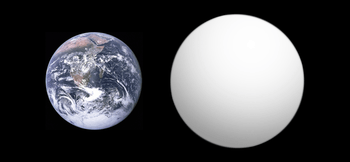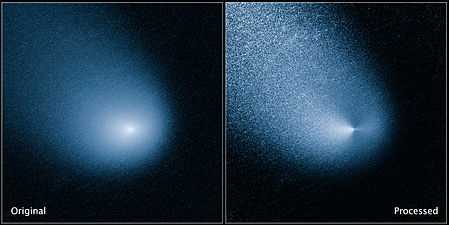Kapteyn b
| Extrasolar planet | List of extrasolar planets | |
|---|---|---|
 | ||
| Parent star | ||
| Star | Kapteyn's star | |
| Right ascension | (α) | 05h 11m 40.58s |
| Declination | (δ) | +45° 01′ 06.3″ |
| Apparent magnitude | (mV) | 8.8 |
| Distance | 12.8 ly (3.92±0.01 pc) | |
| Mass | (m) | 0.281±0.014 M☉ |
| Radius | (r) | 0.291±0.025 R☉ |
| Temperature | (T) | 3550±50 K |
| Metallicity | [Fe/H] | -0.89 |
| Age | 8.0±7.5 Gyr | |
| Physical characteristics | ||
| Mass | (m) | 4.8+0.9 −1.0 M⊕ |
| Orbital elements | ||
| Semimajor axis | (a) | 0.168+0.006 −0.008 AU |
| Eccentricity | (e) | 0.21+0.11 −0.10 |
| Orbital period | (P) | 48.616+0.036 −0.032 d |
| Discovery information | ||
| Discovery date | 2014 | |
| Discoverer(s) | ||
| Discovery method | Radial Velocity | |
| Discovery status | Published refereed article | |
| Other designations | ||
| Kapteyn b; HIP 24186 b; 2MASS J05114046-4501051 b; TYC 8078-01749-1 b; IRAS 05100-4502 b; WISE J051146.81-450204.5 b; CPD-44 612 b; SAO 217223 b; GJ 191 b; VZ Pic b; Kapteyn's star b; LHS 29 b; HD 33793 b; CD-45 1841 b | ||
| Database references | ||
| Extrasolar Planets Encyclopaedia | data | |
| SIMBAD | data | |
| Exoplanet Archive | data | |
| Open Exoplanet Catalogue | data | |
Kapteyn b is an exoplanet that orbits the red dwarf Kapteyn's star, located approximately 12.8 light-years (3.92 pc) from Earth. Kapteyn b is within the estimated habitable zone of its star.[2] It is the closest suspected habitable exoplanet to our solar system other than Tau Ceti e.
Kapteyn b has a mass greater than or equal to 4.8±1 M⊕ and is 0.168AU from the host star orbiting in 48.61 days with an eccentricity of 0.21±0.1.
The system itself is estimated to be 11.5 billion years old, substantially older than the Solar System.[2]
Discovery
The planet was first discovered by the HARPS spectrometer which is housed at the European Southern Observatory's La Silla Observatory in Chile. Further confirmations of the planetary detection where made at the Keck Observatory in Hawaii and at the PFS Observatory, also in Chile.[2]
Methodology
The method of discovery involved observing and recording tiny wobbles in the star caused by the gravitational tug of its planets, using Doppler spectroscopy.[2]
Additional planet
One other planet has been detected within the same planetary system. It is designated "Kapteyn c" and orbits further out from the star, beyond the outer edge of the habitable zone.[2] It is considered to be too cold for stellar-light based life.[2]
See also
References
- ↑ Anglada-Escude, G. et al. (8 July 2014). "Two planets around Kapteyn's star: a cold and a temperate super-Earth orbiting the nearest halo red dwarf". Oxford Journals. doi:10.1093/mnrasl/slu076. Retrieved 10 January 2015.
- ↑ 2.0 2.1 2.2 2.3 2.4 2.5 2.6 Wall, Mike (3 June 2014). "Found! Oldest Known Alien Planet That Might Support Life". Space.com. Retrieved 10 January 2015.
External links
- NASA – Kapteyn b at The NASA Exoplanet Archive.
- NASA – Kapteyn b at The Extrasolar Planets Encyclopaedia.
- Habitable Exolanets Catalog at UPR-Arecibo.
| ||||||||||||||||||||||||||||||||||||||||||||||||||||||||
| ||||||||||||||||||||||||||||||||||||
| ||||||||||||||||||||||||||||||||||||||||||||
| |||||||||||||||||||||||||||||||||||||||||


